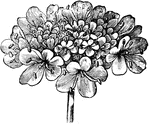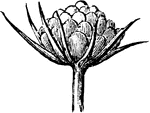Clipart tagged: ‘perennial plant’

European Columbine
Aquilegia vulgaris is a perennial plant also known as the European columbine or Granny's Nightcap.

Inflorescence of Field Scabious
An illustration of the inflorescence of the field scabious. Knautia arvensis, commonly known as Field…

Ray-floret of Field Scabious
An illustration of a ray-floret of the field scabious. Knautia arvensis, commonly known as Field Scabious,…

Ray-floret of Field Scabious
An illustration of a ray-floret of the field scabious. Knautia arvensis, commonly known as Field Scabious,…

Seed of Field Scabious
An illustration of the seed of the field scabious. Knautia arvensis, commonly known as Field Scabious,…

Young Inflorescence of Field Scabious
An illustration of the young inflorescence of the field scabious. Knautia arvensis, commonly known as…

Indian Cucumber-root
An illustration showing both the flower (a) and fruit (b) of the Indian Cucumber-root plant. Medeola…